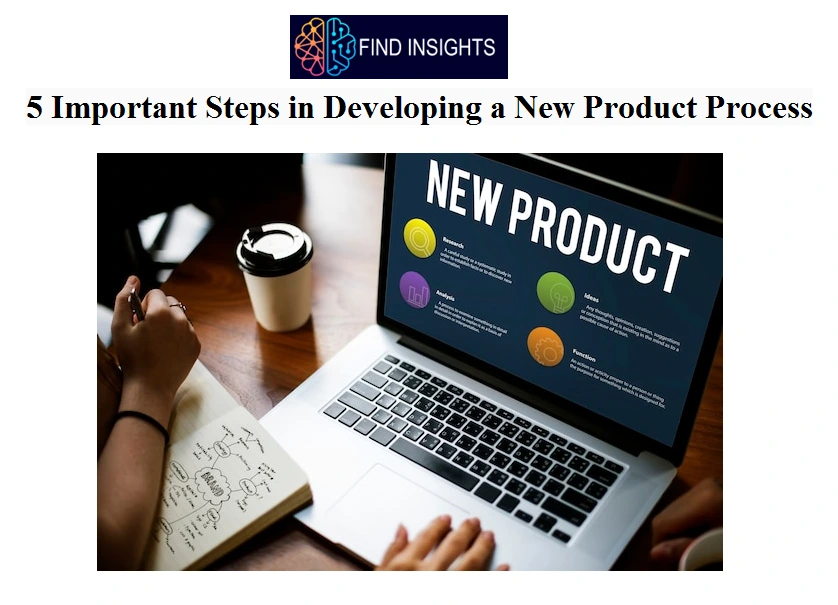
Developing a New Product Process – Introduction:
Every company must develop new products. New-product development shapes the company’s future. Replacement products must be created to maintain or build sales. Customers want new products, and competitors will do their best to supply them. Each year over 16,000 new products (including line extensions and new brands) are introduced into groceries and drugstores. Let’s see 5 Important Steps in Developing a New Product Process.
5 Important Steps in Developing a New Product Process

1. Idea Generation
- The new-product development process starts with the search for ideas. Top managers should define the product and market scope and the new product’s objectives.
- They should state how much effort should be devoted to developing breakthrough products, modifying existing products, and copying competitors’ products.
New-product ideas Sources:
- New-product ideas can come from many sources: customers, scientists, competitors, employees, channel members, and top management.
- The marketing concept holds that customer needs and wants are the logical place to start the search for ideas. Highest percentage of ideas for new industrial products originate with customers ‘Technical companies can learn a great deal by studying their lead users, those customers who make the most advanced use of the company’s products and who recognize the need for improvements before other customers do.
- Many of the best ideas come from asking customers to describe their problems with current products. Idea generation is the first Step in Developing a New Product Process
2. Idea Screening
- Any company can attract good ideas by organizing itself properly. The company should motivate its employees to submit their ideas to an idea manager whose name and phone number are widely circulated.
- Ideas should be written down and reviewed each week by an idea committee, which sorts them into three groups : promising ideas, marginal ideas, and rejects. Each promising idea is researched by a committee member, who reports back to the committee.
- The surviving promising ideas then move into a full-scale screening process. The company should reward employees submitting the best ideas.
- The purpose of screening is to drop poor ideas as early as possible. The rationale is that product-development costs rise substantially with each successive development stage. Most companies require new-product ideas to be described on a standard form that can be reviewed by a new-product committee. Idea Screening is one of the important steps in Developing a New Product Process.
3. Concept Development
- A product idea is a possible product the company might offer to the market.
- A product concept is an We shall illustrate concept development with the following situation: A large food processing company gets the idea of producing a powder to add to milk to increase its nutritional value and taste.
- This is a product idea. But consumers do not buy product ideas; they buy product concepts.
4. Concept Testing
- Attractive ideas must be refined into testable product concepts. elaborated version of the idea expressed in meaningful consumer terms.
- Concept testing involves presenting the product concept to appropriate target consumers and getting their reactions.
- The concepts can be presented symbolically or physically. However, the more the tested concepts resemble the final product or experience, the more dependable concept testing is.
5. Conjoint Analysis
- Consumer preferences for alternative product concepts can be measured through conjoint analysis, a method for deriving the utility values that consumers attach to varying levels of a product’s attributes.
- Respondents are shown different hypothetical offers formed by combining varying levels of the attributes, then asked to rank the various offers. Management can identify the most appealing offer and the estimated market share and profit the company might realize.
Final Thoughts on Developing a New Product Process
- New-product development is most effective when there is teamwork among R & D, engineering, manufacturing, purchasing, marketing, and finance.
- The product idea must be researched from a marketing point of view, and a specific cross-functional team must guide the project throughout its development.
- New-product successes are due in large part to cross-functional teamwork.
LIKE WHAT YOU’RE READING?
CHECK OUT SOME OF OUR OTHER GREAT CONTENT HERE:
- 10 WAYS TO DEVELOP A NEW PRODUCT IDEAS [2023]
- EFFECTIVE METHODS OF SALES PROMOTION TO WIN MORE CUSTOMERS
- 12 LATEST STRATEGIES FOR MARKETING A PRODUCT
- ROLE OF BLOGS IN MARKETING
- UNDERSTANDING DIGITAL MARKETING
- PERFORMANCE MARKETING – A BEGINNER’S GUIDE
- EFFECTIVE BRANDING METHODS
- UNDERSTANDING CONSUMER BEHAVIOR
- 5 BEST SOCIAL MEDIA PLATFORMS FOR BUSINESS IN 2022
- ROLE OF SOCIAL MEDIA IN MARKETING
- 5 BEST TOOLS FOR DIRECT MARKETING WITH ADVANTAGES IN DETAIL
- 5 BEST MARKETING STRATEGY IN PRODUCT LIFE CYCLE FOR 2023
- 8 STRATEGIES OF RETAIL MARKETING TO DRIVE SALES
- WHAT IS THE IMPORTANCE OF MARKETING IN A BUSINESS?
- THE ROLE OF MARKETING IN STRATEGIC PLANNING




8 Comments